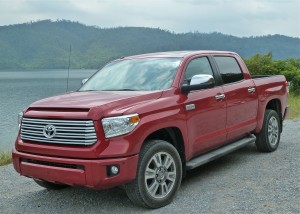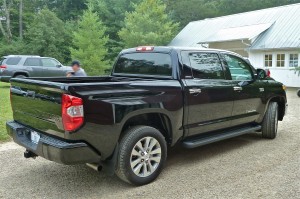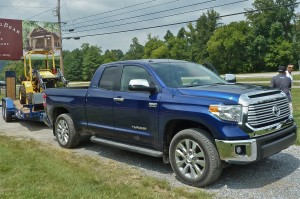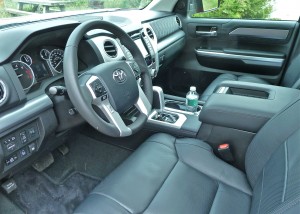Tundra Revises Look, Features for 2014
By John Gilbert
After years of passing every test thrown at it, Toyota would like to reverse roles with the Tundra — asking competitors to pass the same tests, and consumers to consider testing the redesigned 2014 Tundra when shopping for a new half-ton pickup.
Toyota isn’t making any outrageous claims for its new Tundra, avoiding the hype that dominates the ad campaigns of competitors in the most brand-loyal segment. Toyota also stops short of trying to steal customers from F-150s, Silverados or Rams, but merely asks such half-ton pickup buyers to test the the Tundra for whatever criteria is important to them.
Through its life, the Tundra started off too small, and has since been accused of being not rugged enough, and/or too fancy. The last major renovation, in 2007, seemed to solve the criticisms, and for 2014, the new Tundra has a focus on refinement, chiseling a more aggressive exterior, and using mostly soft-touch and luxury touches to refine the interior. Improving the interior appearance is interesting, because the creature comforts of the first Tundra caused me to define it as the Lexus of pickup trucks, and it has inspired the competition to drastically upgrade their interior amenities.
A bolder look and stance sets the new Tundra apart from the current model, and while the truck continues with the same powertrains that is more an affirmation that its powerful array of high-tech engines is already substantial enough to take on the improved power of the competition.
When it comes to the perpetual tests the half-ton pickup players always face, Chris Gomez, chief product planner for Toyota’s large trucks, said he is both curious and amused at the lavish claims made for towing as Tundra competitors seemingly escalate their limits to claim the highest number, while Toyota prefers to pass the approved standards.
“In the half-ton pickup segment, we have something called the ‘SAE J-2807’ for towing standards,” said Gomez. “All truck manufacturers were at the table when we agreed on the tests and methods. The tests are done on a 12-degree grade, measuring acceleration, minimum speed, cooling system, braking distance, transmission locks, and every other characteristic, all done with a load, and in over 100-degree heat, to see how every component will function, and what its failure points might be.
“While everyone agreed on five primary tests and minimum requirements, Toyota is the only one that passed all the tests. None of the others meet the J-2807 standards, and Toyota has adhered to them since they were adopted in 2011.”
Truck makers can claim whatever lofty towing figures they choose, but meeting the SAE standards is important, and Gomez said the standards are part of a transparency issue. According to the J-2807 methodology, the Tundra towing capacity for the V8 CrewMax 4×4 is 9,000 pounds, rising to 9,800 pounds for the DoubleCab 4×4, 9,900 for the 4×2 CrewMax, 10,100 pounds for both the Regular Cab 4×4 and the DoubleCab 4×2, with the maximum 10,400 pounds for the Regular Cab 4×2.
“The Tundra is compliant with the 10,500-pound tow weight,” said Gomez. “Other manufacturers may claim much higher numbers than that, but all are capable, so why not be straightforward? The majority of truck-owners tow trailers that are under 8,000 pounds. But there is a safety measure built into the standards, too. If you own a boat, and your pickup will tow it easily, then you decide you want a bigger boat. Do you know your truck is capable of towing the heavier boat?”
Our tests included driving around from a base at Blackberry Farm, a quaint farm converted into a luxurious resort, while still a working farm in the Smokey Mountain foothills near Knoxville, Tennessee. We drove many miles on area highways. At one point we drove a couple of Tundras hitched to trailers with about 12,000 pounds of farm or construction machinery like backhoes, loaded onto trailers. The Tundras pulled away, drove up to cruising speed, and maneuvered around before returning. The power was easily adequate, and the transmission never missed a beat, while handling and braking almost made you forget you were hauling a huge trailer.
Tundras come in three cab configurations — regular, double cab, and CrewMax, with all three available in the choice of 4×4 or 4×2, and with standard, short, or long beds, measuring 66.7, 78.7, or 97.6 inches. All the beds are 22.2 inches deep.
Since pickups have become as well appointed as any car or SUV, Toyota has expanded Tundra’s models to five variations. The base model is the SR, moving up to the SR5. The Limited is the popular and luxurious next grade, then the enhanced Platinum. For 2014, a new 1794 model is available, loaded with options. The 1794 is named after the year the original ranch started in San Antonio, Texas, where Toyota now has a sophisticated truck-building facility.
Prices remain about the same for all models, which represents a reduction when you compute the newly added features. They range from $25,920 for the base SR Regular Cab with the V6, rising quickly to over $30,000 for 4×4 and longer cab models of the SR5, and, for those demanding more SUV-like luxury than just a basic working truck, stickers reach well over $40,000 for the top Limited, or Platinum and 1794 models.
Under the hood, all three available engines burn 87-octane regular fuel. The primary engine is a 5.7-liter V8 with dual overhead camshafts, four valves per cylinder, dual variable valve-timing, and 381 horsepower with 401 foot-pounds of torque. That is the most popular as well as the most potent engine, Toyota offers two alternative engines with less power but no less technology.
A 4.6-liter V8 has 310 horsepower and 327 foot-pounds of torque. And those who don’t need the extra towing or hauling power will find adequate performance from a 4.0-liter V6 with 270 horsepower and 278 foot-pounds of torque. Both the 3.6 V8 and the 4.0 V6 also have four valves per cylinder, DOHC and variable valve timing. The V6 has a 5-speed automatic while the two V8s get an electronically controlled 6-speed transmission.
The Tundra’s more rugged exterior features a taller grille and better coordination with lower panels. The interior features pleasing enough materials on the base SR, but the quality increases dramatically as you move up to the leather, pleated leather, and finally exclusive brown embossed leather on the 1794 model, with its western ranch motif. The center stack controls have been moved a couple of inches closer and angled toward the driver for easier use, with soft-touch coverings for the dashboard, doors and console.
Smooth performance is assured with the Triple Tech frame, using full-boxed rails in front, a reinforced C-channel under the cab, and an open C-channel under the bed for strength and ride quality. Four-wheel disc brakes have antilock, and electronic brake distribution and brake assist to supplement the driver’s effort to stop. Standard limited-slip helps traction in sand, mud, snow, or mixed surfaces better than a conventional mechanical limited slip differential because it integrates traction control and is more responsive.
A towing package adds tow/haul mode for adjusting throttle sensitivity and shift control, holding lower gears while accelerating or decelerating with trailer sway control, which uses the stability control to counteract any trailer sway. All the contemporary electronic connectivity devices are available, incluyding a nav screen, and a backup camera, Bluetooth and audio streaming are standard on all models.
When Toyota first decided to build the Tundra, it built a model that was halfway between compact and full-sized trucks. Since becoming a full-fledged, full-sized pickup, the Tundra has become a worthy competitor for the top half-tons from Ford, Chevrolet and Dodge. With the new 2014 upgrade in styling and other features, the new Tundra passes any and every test full-size pickup buyers can come up with, in a refined truck that is designed, engineered and built entirely in the United States.
Comments
Tell me what you're thinking...
and oh, if you want a pic to show with your comment, go get a gravatar!






 John Gilbert is a lifetime Minnesotan and career journalist, specializing in cars and sports during and since spending 30 years at the Minneapolis Tribune, now the Star Tribune. More recently, he has continued translating the high-tech world of autos and sharing his passionate insights as a freelance writer/photographer/broadcaster. A member of the prestigious North American Car and Truck of the Year jury since 1993. John can be heard Monday-Friday from 9-11am on 610 KDAL(www.kdal610.com) on the "John Gilbert Show," and writes a column in the Duluth Reader.
John Gilbert is a lifetime Minnesotan and career journalist, specializing in cars and sports during and since spending 30 years at the Minneapolis Tribune, now the Star Tribune. More recently, he has continued translating the high-tech world of autos and sharing his passionate insights as a freelance writer/photographer/broadcaster. A member of the prestigious North American Car and Truck of the Year jury since 1993. John can be heard Monday-Friday from 9-11am on 610 KDAL(www.kdal610.com) on the "John Gilbert Show," and writes a column in the Duluth Reader.